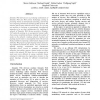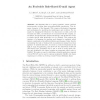P2P
2002
IEEE
14 years 4 months ago
2002
IEEE
Semantic Web Services are a promising combination of Semantic Web and Web service technology, aiming at providing means of automatically executing, discovering and composing seman...
COOPIS
2002
IEEE
14 years 4 months ago
2002
IEEE
The Semantic Web is a vision of the next generation Web, in which semantic markup will make Web resources more accessible to automatic processes. Description Logics (DLs) are of cr...
COOPIS
2002
IEEE
14 years 4 months ago
2002
IEEE
Because the ultimate purpose of the Semantic Web is to help users locate, organize, and process information, we strongly believe that it should be grounded in the information acces...
ITNG
2010
IEEE
14 years 4 months ago
2010
IEEE
—In reservoir engineering domain experts deal with many tasks and operations, ranging from reservoir simulation to well maintenance scheduling, with the goal of maximizing oil pr...
AINA
2010
IEEE
14 years 4 months ago
2010
IEEE
—In order for Semantic Web applications to be successful a key component should be their ability to take advantage of rich content descriptions in meaningful ways. Reasoning cons...
ISCIS
2003
Springer
14 years 4 months ago
2003
Springer
The Web is mainly processed by humans. The role of the machines is just to transmit and display the contents of the documents, barely being able to do something else. Nowadays ther...
ICWE
2003
Springer
14 years 4 months ago
2003
Springer
The Web is mainly processed by humans. The role of the machines is just to transmit and display the contents of the documents, barely being able to do something else. Nowadays ther...
ICADL
2003
Springer
14 years 4 months ago
2003
Springer
Ontologies play an important role in the Semantic Web as well as in digital library and knowledge portal applications. This project seeks to develop an automatic method to enrich e...
EPIA
2003
Springer
14 years 4 months ago
2003
Springer
The Semantic Web is a “living organism”, which combines autonomously evolving data sources/knowledge repositories. This dynamic character of the Semantic Web requires (declarat...
CIA
2003
Springer
14 years 4 months ago
2003
Springer
The so-called "Web of Trust" is one of the ultimate goals of the Semantic Web. Research on the topic of trust in this domain has focused largely on digital signatures, ce...


